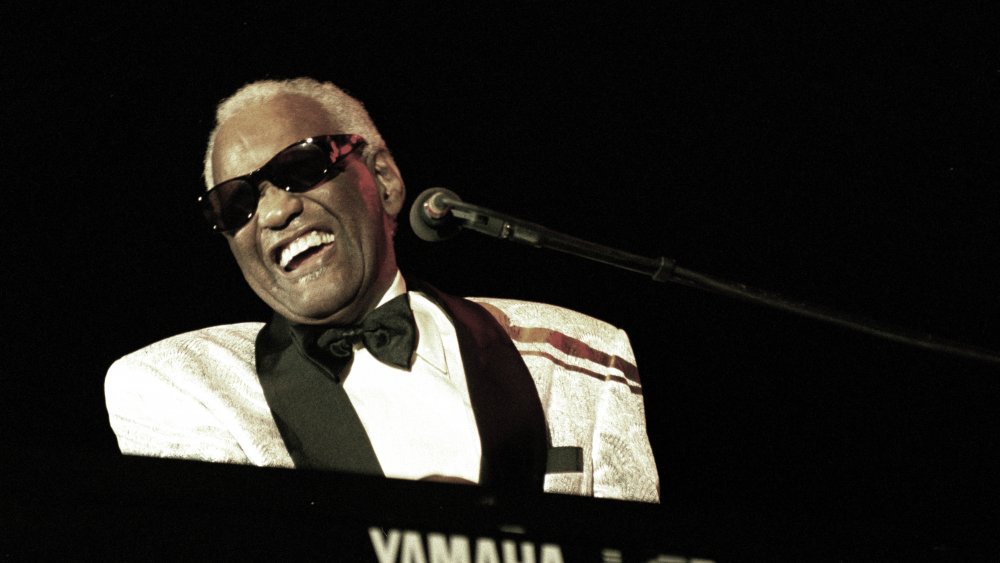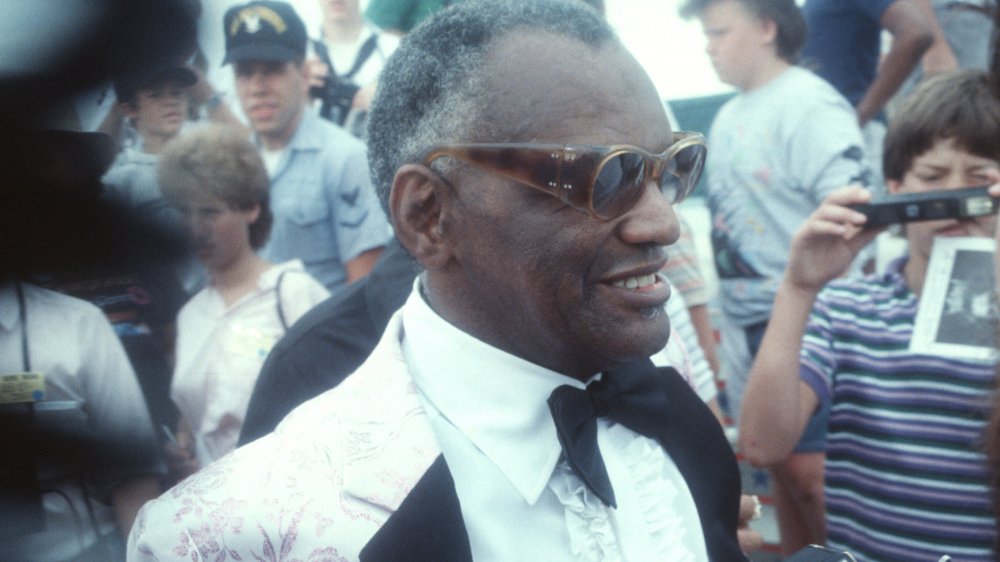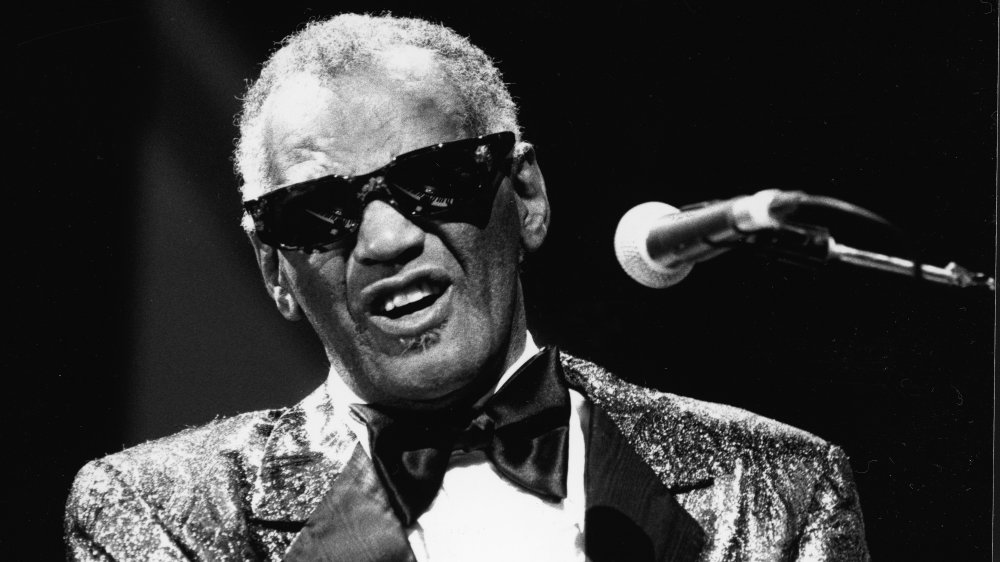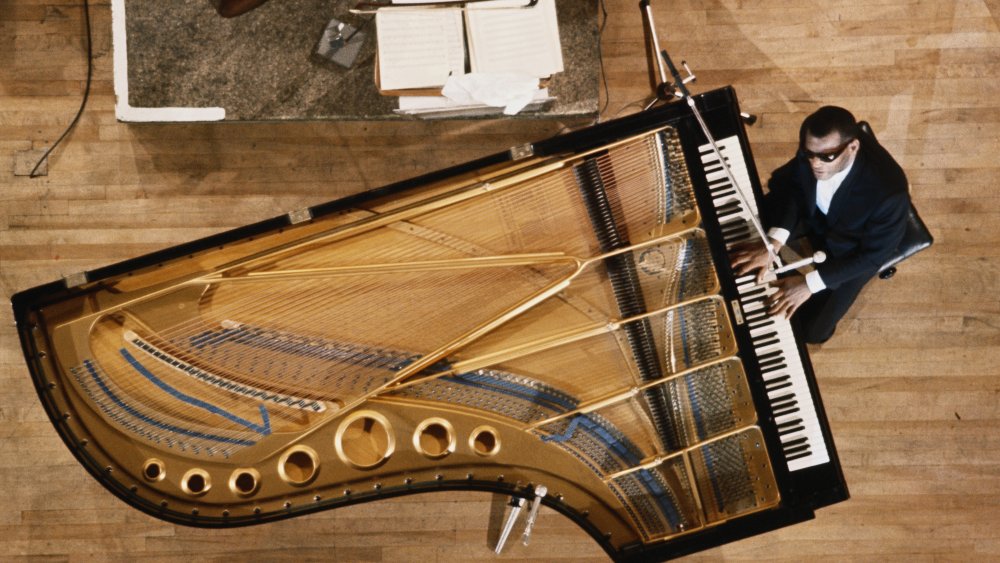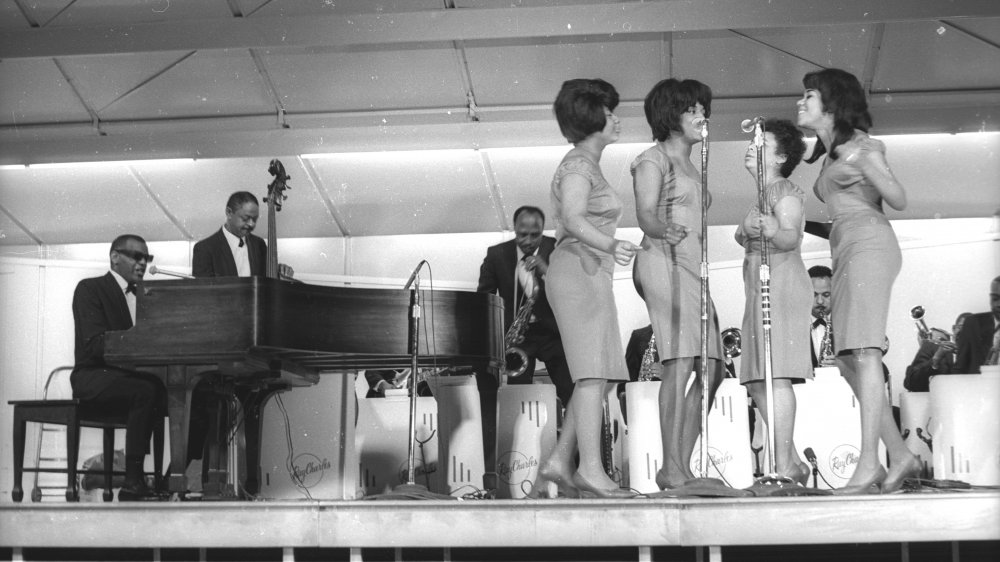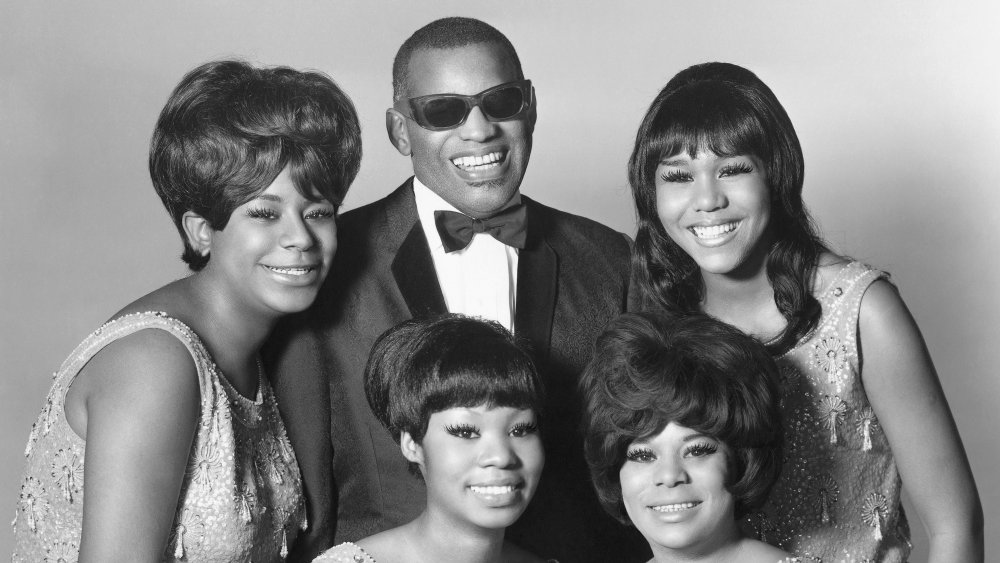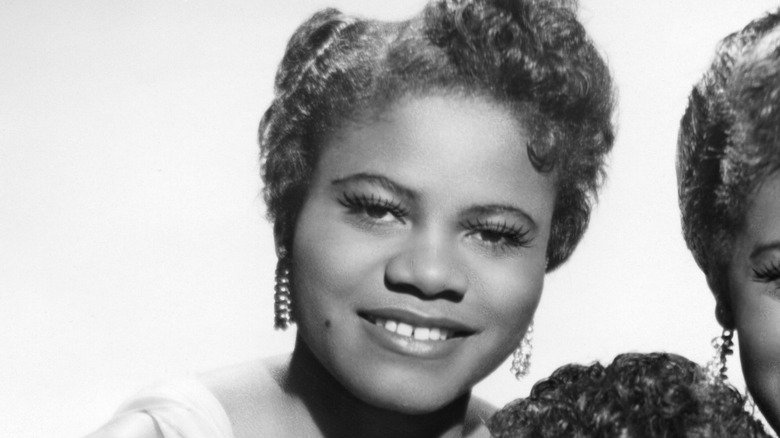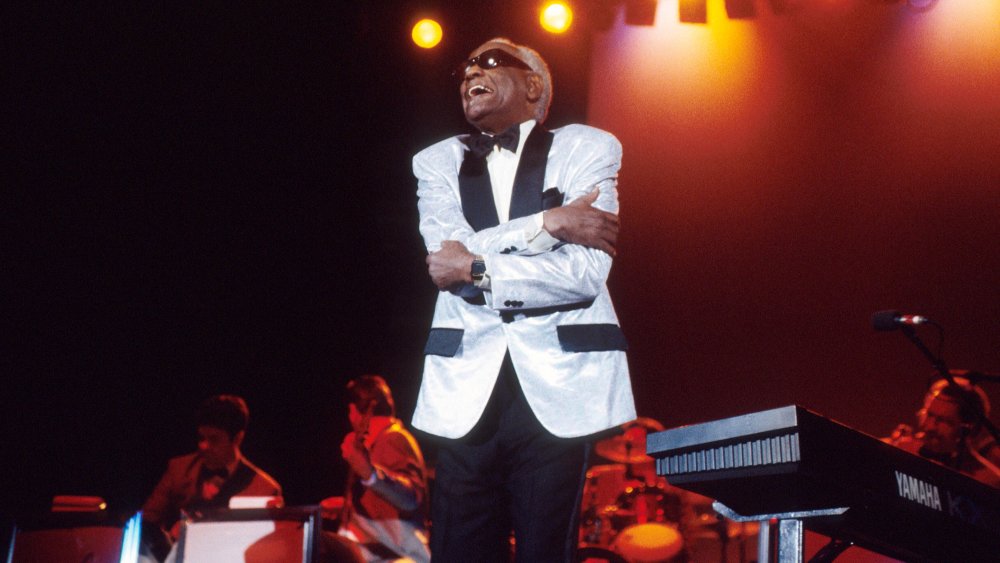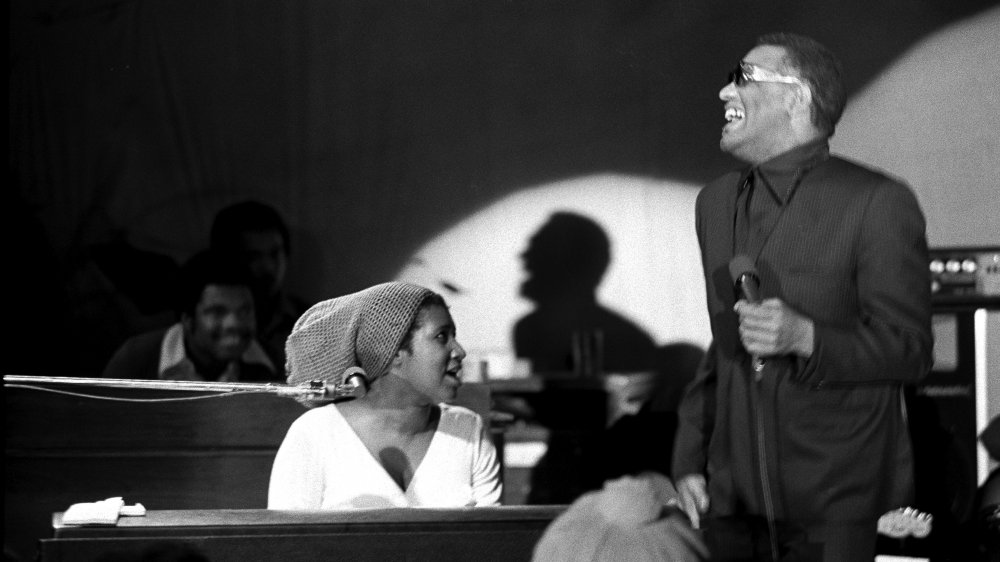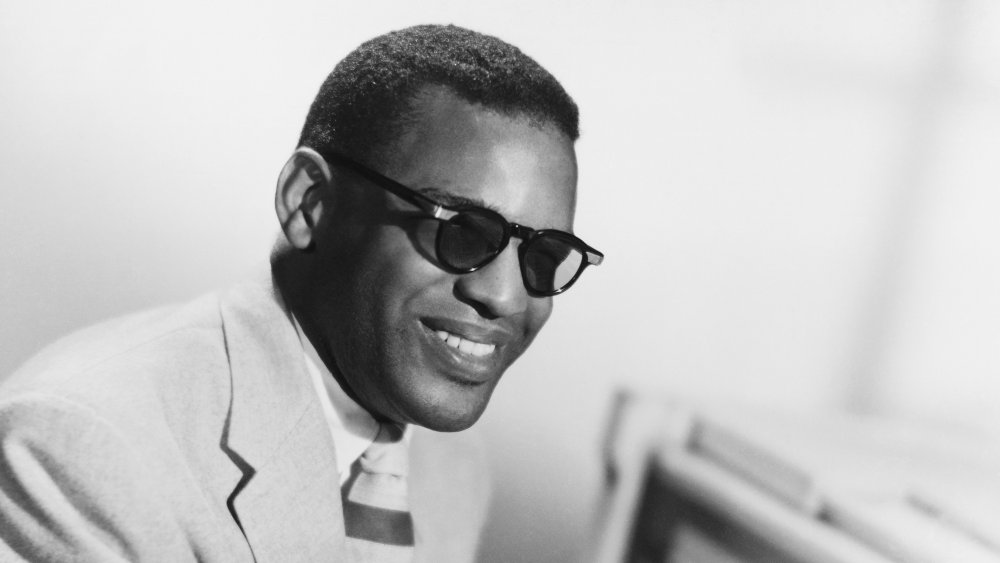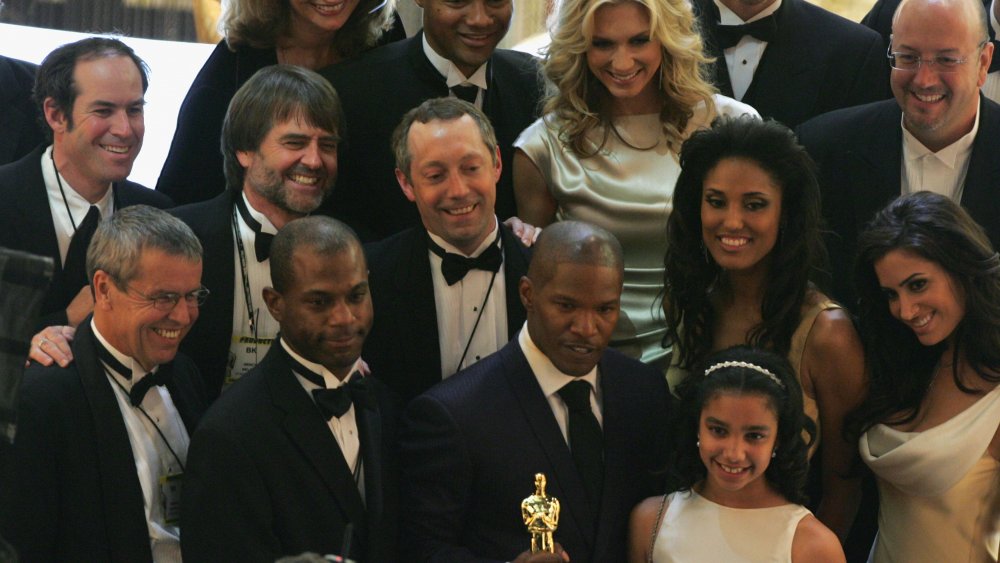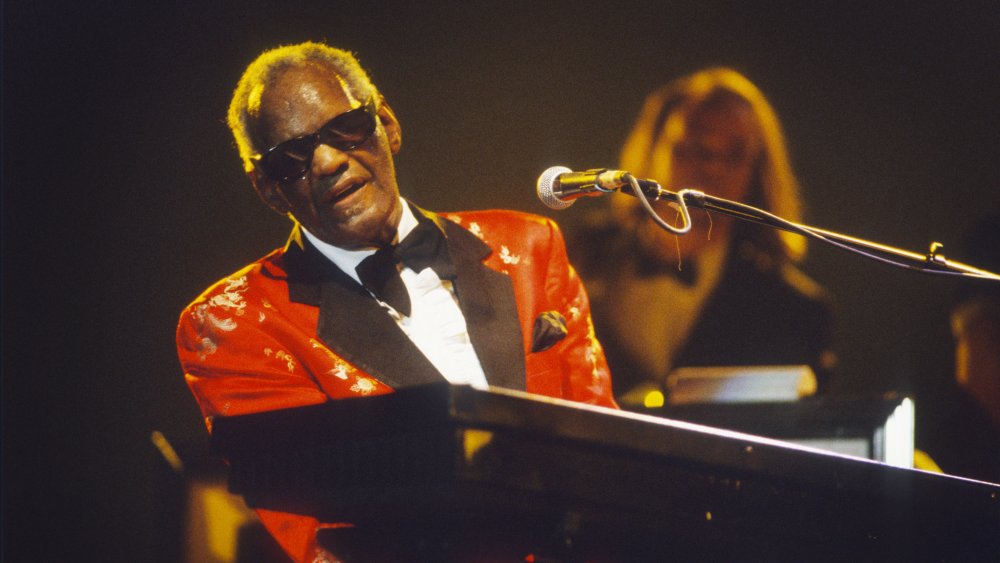The Tragic Real-Life Story Of Ray Charles
We may receive a commission on purchases made from links.
When the Chairman of the Board calls you "the only true genius in our business," there really isn't much more to be said. Frank Sinatra hit the nail perfectly on the head when describing his former friend, Ray Charles. Charles is one of the most important musicians of the 20th century. As stated in The Independent, Charles practically invented soul music, combining the "sensual and secular preoccupations of the blues and the galvanic fervor of gospel." Charles took all the music he heard in the Jim Crow South, the gospel and blues he mixed to form soul as well as country, jazz, and R&B, and formed an influential musical legacy.
At the turn of the 21st century, Charles was bought back to relevance for a new audience when, only months after his passing in 2004, Jamie Foxx gave an Oscar-winning performance in a biopic of the famed singer. A year later, Charles' voice was sampled by Kanye West for the hit song, "Gold Digger," featuring Foxx. The song became nominated for Record of the Year and won Best Rap Solo Performance at the 2005 Grammys.
Charles accomplished all this during and after his lifetime despite losing his eyesight very early in his childhood. Unfortunately, his blindness was not the only hardship Charles had to face during his life. Personal demons and childhood trauma affected him during his seven-plus decades on Earth. This is the tragic real-life story of Ray Charles.
Ray Charles lost his brother in an accident
Ray Charles Robinson was born on September 23, 1930, to Bailey Robinson and Aretha Williams. According to History Links, Charles' father only appeared a few times throughout Ray's early life and eventually left the family all together, leaving Aretha to care for Ray and his younger brother, George. In his 1978 autobiography, Brother Ray: Ray Charles' Own Story, Charles said this about his father: "The old man wasn't part of my life. [...] He was a tall dude — I remember that. But he was hardly around... He was so big and she [Aretha] was so small that people often confused them for father and daughter."
Though a year younger than Ray, George was described by his brother in his autobiography as someone who, by the age of three, could add, multiply, and divide to the amazement of neighbors who watched him perform mathematics. Ray talks about his early childhood, despite an absent father, as fulfilling and joyful. He said he enjoyed the glow that came from matches he sparked at night.
The young Ray, however, suffered a life-altering loss at age five. One day, he and his brother were playing in the backyard when four-year-old George slipped and fell into a large metal tub used by his mother to clean their clothes. Ray couldn't pull George, weighed down by the soapy clothes, out. He ran inside to find his mother, who pulled out her son, but sadly, George Robinson was already gone.
Glaucoma took Ray Charles' vision at age seven
The loss of his brother marked the first of many tragedies in Ray's childhood. Around the same time young Ray witnessed George's drowning, his eyesight began to worsen. By the age of seven, he was completely blind. His blindness, according to the Industries for the Blind and Visually Impaired, is believed to have been the result of glaucoma. Seeing that the Robinson family grew up in poor in the segregated South, the best medical treatment was not available for Ray.
The Smithsonian Institute details that from the mid-19th and early 20th century, many African Americans "living in insufficient conditions" like Charles went blind because of a lack of quality health care. Many other famous Black musicians during the 1920s and '30s suffered blindness, such as Blind Tom Wiggins and Blind Lemon Jefferson. Blindness, as described in the article, was used in the marketing of these musicians to portray the suffering, weary blues singer beaten down by life.
According to Live About, Aretha Williams would never let her son use his blindness as an excuse. Charles recalls his mother telling him, "You're blind, you ain't dumb; you lost your sight, not your mind." Ray said he didn't pick up the guitar like other blind African American musicians because of its association with blindness and helplessness. Young Ray heeded his mother's words and did not want his blindness to be an excuse to be pitied.
The tragic life of Ray Charles' mother
Aretha Williams was only a 15-year-old teenager when she had Ray. By comparison, Bailey Robinson was not only much older and married, but according to Irene Earls' book, Young Musicians in World History, he had taken Aretha in when she was an orphan. So the young teen became pregnant by her foster father. The scandal in the town led Aretha to leave Greenville, Florida, for Albany, Georgia, to have Ray. She returned to Greenville with her young baby, and despite Bailey's absenteeism, Bailey's wife, Aretha's foster mother Mary Jane, remained close with Aretha and helped care for Ray.
Aretha was not a very healthy woman. At a young age, she had to walk with a cane. According to Ray Charles' biography, You Don't Know Me: Reflections of My Father, Ray Charles, written by his son, Ray Charles Robinson Jr., the family lived "at the bottom of the economic ladder," even compared to the rest of the neighborhood. According to his son, Charles said "there was nothing between him and the bottom but dirt."
After George's death and Ray's blindness, Aretha Williams made sure her son was given the best opportunity for success. She looked for a way to help her son and found it with the Florida School for the Deaf and the Blind in St. Augustine. With the help of family friends and persistence, she got her son into the school in 1937. Aretha Williams died in 1945 when Ray was a teenager.
Early struggles in Ray Charles' career
There's struggling as a young musician, and then there's Ray Charles' struggling. Blind, poor, tormented by his brother's death, and living in the Jim Crow South, "The Genius" had enough emotional baggage for an airplane. This was compounded by the fact that Ray was orphaned after his mother's death, as his absent father had died several years earlier.
During his eight years at the Florida School for the Deaf and Blind, Charles studied music. He learned to read, write, and compose music in braille and learned to play the saxophone, trumpet, clarinet, and keyboards at the school. The classical music training Charles received fit well with his experience before the school. Ray first learned to play upright piano as a child from a local store owner named Wylie Pitman.
Charles left the school to work as a professional musician following his mother's passing. He traveled to Jacksonville and spent the next three years as a road musician around Florida. At points during this time, according to the biography Ray Charles: Singer and Musician, Charles lived in poverty and would sometimes go days without food. It was also during this period in Charles' life that he was first introduced to heroin.
According to his website, the teenage musician raised enough money to travel to Seattle to work as a crooner in the same vein as Nat King Cole. In order to avoid confusion with the popular boxer Sugar Ray Robinson, Ray Charles dropped his last name Robinson professionally.
Ray Charles' marriage to Della Beatrice Howard
For 22 years, Della Beatrice Howard, also known as "Bea," was married to Ray Charles, and the couple had three sons. During those two decades plus, however, Charles had five children with five different women outside of the three he had with his wife.
Earn the Necklace says that Charles met Bea when she became one of his backup singers, and they married a year later in 1955. Ray, at this point in his life and career, had already been married to a woman named Eileen Williams (a union which lasted only a year) and had already fathered a child with another woman. Ray and Bea got married and had their first child, Ray Charles Robinson Jr., in 1955.
Professionally, Charles had begun to take over the R&B charts with songs such as "I Got a Woman" and "A Fool for You." Rare reports that the success led to more tours of Black venues known as "the chitlin' circuit," away from Bea. When his first son was born, in fact, Charles was performing in Texas. Like with Bea, Charles had begun to fall for another backup singer, Margie Hendrix, whom he had a son with and can be heard singing on the hit song, "Night Time is The Right Time." Charles' drug addiction, affairs, and career became too much, and the pair divorced in 1977. Charles would never remarry.
Ray Charles' relationship with Margie Hendrix
In the late 1950s, Charles decided to add the Cookies, a New York group, as his backup vocalists. The group consisted of Dorothy Jones, Darlene McCrea, and Margie Hendrix, who would become one of the many women who would have an affair with Charles and have a child with him.
Marjorie "Margie" Hendrix (or Hendricks) was born on March 13, 1935, in Register, Georgia, and, according to People Pill, she sang, played piano, and directed her church's choir as a teen before moving to New York to pursue a music career. In 1956, Margie replaced Beulah Robertson and joined the Cookies. The group soon signed with Atlantic Records, and in 1958, Hendrix and McCrea left their group and became the Raelettes, Charles' backup singers.
Charles and Hendrix's affair began in the late 1950s and continued until she left the Raelettes following a fight with Charles in 1964. Sir Shambling says that while Ray's vice was drugs, Margie's vice was alcohol, which led to a volatile relationship between the pair. After the Raelettes, Margie moved to Los Angeles to pursue a solo career.
Margie died in July 1973 of what is believed to have been a drug overdose. Regina King said this when trying to research her role of Margie for the 2004 Ray Charles biopic: "There's very little written about Margie Hendricks, which is pretty amazing because she had one of the most unique voices ever in American music."
Radio stations banned What'd I Say
"What'd I Say" was considered by Rolling Stone as the tenth-best song ever on their list of the "500 Greatest Songs of All Time." The iconic opening electric piano rift and Charles' passionate vocals broke the R&B star to mainstream pop success. According to Chimes Freedom, Charles said that the song was created at the end of a concert as he was trying to finish the final minutes of his contracted time for a performance. Ray called Atlantic following a few performances of the song, saying, "I'm playing a song out here on the road, and I don't know what it is [...] but the people are just going wild every time we play it, and I think we ought to record it."
According to an essay penned by Michael Lyndon, upon its release, the song was met with a great amount of controversy and was even banned from certain stations for its risqué innuendos. Even Black-owned stations did not like the fact that the song mixed secular lyrics with gospel-inspired music. Still, "What'd I Say" was a hit among young people and propelled Charles from the R&B charts to the Top 10 on Billboard.
Ray Charles had officially crossed over to become a pop star, and just in time, as his Atlantic contract was soon to expire. Within six months, The Washington Post reports, Charles had signed a more lucrative contract with ABC.
Ray Charles' drug addiction led to run-ins with the law
Drug addiction is a classic musician stereotype. Ray Charles, despite being unique in many ways during his career, wasn't unique in any way in this regard. The only exception might be how young he was when he first began to use drugs. Jet magazine reported back in 1961 that following an arrest after police found a jar of marijuana, a hypodermic syringe, and a gelatin capsule that had heroin residue, Charles admitted to having been a drug user since he was 16 years old.
According to Recovery Ranch, promoters for the venues he played gave Charles marijuana to help his performance anxiety. Soon, his marijuana use turned into heroin use, and the teenage musician spent the next decade and a half addicted to the drug. Charles later faced another drug arrest, but according to Super Lawyers, he avoided jail time by entering rehab.
Black Doctor reports that Charles' drug use was to stop the nightmares he'd experienced since witnessing his brother's drowning. In 1966, after being released from rehab and swearing off drugs, Charles put his new life into his music, recording songs about his experiences such as "Let's Go Get Stoned" and "I Don't Need No Doctor." His 1966 album, Crying Time, was made with his experiences fighting through drug addiction in mind.
Ray Charles struggled with alcohol
After leaving rehab, for the first time since his early teens, Ray Charles was no longer a drug addict. While this would be celebrated in most regards, another equally damaging vice took hold of Charles in the form of alcohol.
While he ended his use of drugs following his stint in rehab in the mid-1960s, Charles continued to drink gin and smoke marijuana until his death. Slate reports that when Charles was working on his autobiography, he said, "Just like smack never got in the way of my working, same goes for booze and reefer. What I do with my own body is my own business." Charles would regret this arrogant declaration toward the end of his life, when his years of alcohol use finally caught up with him. In 2003, he was diagnosed with alcoholic liver disease and hepatitis C. The 73-year-old musician said, "If I knew I was going to live this long, I would have taken better care of myself."
Dr. Mirkin details how Ray Charles' drug and alcohol use led to illness later in life. The liver is the only organ with the enzymes to break down alcohol, meaning excessive alcohol puts a strain on the liver. The liver also breaks down recreational and prescription drugs. The combination of many sexual partners and excessive drug and alcohol use throughout his life led to Charles' body suffering greatly in his later years.
Ray Charles' body broke down in his final years
A half-century of performing and touring, addiction to drugs and alcohol, and years of womanizing finally took its toll on Ray Charles at the turn of the century. In 2003, at the age of 73, Charles was forced to cancel a tour to recover from hip surgery. According to KUSA, it was his first canceled tour in 53 years. Charles' spokesman, Jerry Digney, said that the musician was looking to tour the following spring.
Unfortunately, while the operation was successful, Biography reports that Charles learned he was suffering from liver disease and that his days were numbered. During the same period, Charles was working on what would be his final two projects: a final album and a biopic about his life. On June 10, 2004, Ray Charles passed away in his Beverly Hills home at the age of 73.
Genius Loves Company, Ray Charles' final album, was released two months after his passing. The album featured duets with some of the biggest names in music, including George Michael, B.B. King, Alicia Keys, and Willie Nelson, just to name a few. According to MTV, Genius Loves Company was Charles' best-selling album of his career and was awarded a Grammy the following year.
When his biopic was released in the autumn of 2004, it was both a critical and commercial success, and Jamie Foxx won a BAFTA Award, Golden Globe, and Academy Award for his portrayal of the famous late musician.
Ray Charles' estate had to sue his children
As reported by Today, artists such as Willie Nelson, Aretha Franklin, Billy Joel, and many others paid tribute to Ray Charles following his passing. Franklin called him "the voice of a lifetime." Bruce Hornsby recalled that Charles appeared "feeble" during one of his final performances, a tribute to Elton John. Ray had to be helped to the piano, but, "When he started singing, that was it. Everyone else was playing for second."
Following the success of his final album and his biopic, Charles seemed to have walked off the stage to a standing ovation. Unfortunately, nobody told that to his dozen children. Celebrity Net Worth reports that Charles was worth $75 million at the time of his death. According to CNN, Charles had met with his children and told them they would each receive $500,000 in exchange for requesting and waiving claims to his estate shortly before his passing. In 2012, Charles' estate sued seven of his children, alleging that they were violating the agreement by sending copyright termination notices to music publishers. According to Fabiosa, in 2015, the estate won a lawsuit that prevented Ray's children from "seeking any further interest in their father's estate."
In June 2008, Universal Studios in Los Angeles lost over 500,000 master recordings in a fire. The New York Times reported that Ray Charles was among many musicians whose work was lost in the inferno.
